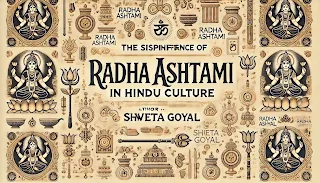The Significance of Radha Ashtami in Hindu Culture
Author: Shweta Goyal
Introduction
Radha Ashtami is a festival that holds profound cultural and spiritual importance in Hinduism. Celebrated with great devotion, it marks the birth of Radha Rani, the beloved consort of Lord Krishna. Radha is revered as the embodiment of pure love and devotion, and her birthday is observed as a day to honor and reflect on these divine qualities. In this post, we will explore the significance of Radha Ashtami within Hindu culture, its symbolism, and how it continues to inspire millions of devotees worldwide.
Radha: The Personification of Divine Love
In Hindu culture, Radha is regarded as the personification of divine love. Her unwavering devotion to Krishna represents the ideal relationship between the soul and the divine. Radha’s love is selfless, unconditional, and transcendent, making her an enduring symbol of Bhakti (devotion). The celebration of Radha Ashtami is an expression of this divine love, where devotees seek to connect with Radha’s spiritual essence and cultivate the same qualities in their own lives.
The Cultural Impact of Radha Ashtami
Radha Ashtami is celebrated with various cultural activities, including music, dance, and drama, all of which depict the divine love story of Radha and Krishna. These performances are not only artistic expressions but also serve as mediums to spread the teachings of devotion and love. Temples are beautifully decorated, and processions are held in many parts of India, especially in Vrindavan and Barsana, where Radha and Krishna’s stories are believed to have taken place. The cultural significance of Radha Ashtami lies in its ability to bring communities together in a shared experience of spirituality and devotion.
Symbolism in Radha Ashtami Celebrations
The rituals and customs associated with Radha Ashtami are rich in symbolism. The Abhishekam (ritualistic bathing) of Radha’s idol symbolizes the cleansing of the mind and soul, preparing the devotee for spiritual enlightenment. The flowers offered during the festival represent the blossoming of devotion in the heart, while the sweets and prasad distributed among devotees signify the sweetness of divine love. Each element of the celebration is designed to remind devotees of Radha’s pure love and to inspire them to cultivate similar virtues in their lives.
Radha Ashtami and Bhakti Tradition
Radha Ashtami is deeply rooted in the Bhakti tradition, which emphasizes personal devotion to a deity as the path to spiritual liberation. In the Bhakti movement, Radha is venerated as the supreme devotee, and her relationship with Krishna is seen as the highest expression of divine love. The stories of Radha and Krishna are central to the teachings of many Bhakti saints, who have used these narratives to inspire devotion among their followers. Celebrating Radha Ashtami is thus an affirmation of the Bhakti tradition and its enduring influence on Hindu spirituality.
The Global Celebration of Radha Ashtami
While Radha Ashtami is primarily celebrated in India, its observance has spread across the world, especially among the Indian diaspora. Temples dedicated to Radha and Krishna in countries such as the United States, the United Kingdom, and Australia host grand celebrations that include kirtans, bhajans, and Aarti. These events bring together devotees from different cultural backgrounds, fostering a sense of global spiritual community. The global celebration of Radha Ashtami highlights the universal appeal of Radha’s love and the timeless relevance of her devotion to Krishna.
Conclusion
Radha Ashtami is a festival that transcends cultural boundaries and speaks to the universal human longing for love and connection with the divine. Through its rich symbolism, cultural activities, and emphasis on Bhakti, Radha Ashtami continues to inspire devotees to seek a deeper spiritual connection and to embody the qualities of love, devotion, and selflessness that Radha represents. As we celebrate Radha Ashtami, may we all be reminded of the transformative power of divine love in our lives.





No comments:
Post a Comment